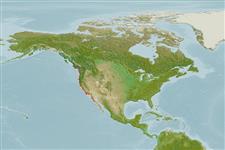Malacostraca |
Decapoda |
Callianassidae
Environment: milieu / climate zone / εύρος βάθους / distribution range
Οικολογία
; Υφάλμυρο. Temperate; 51°N - 29°N, 129°W - 115°W (Αναφ. 4)
Eastern Pacific. Climate: subtropical to temperate.
Length at first maturity / Μέγεθος / Weight / Age
Γεννητική Ωρίμανση: Lm ? range ? - ? cmCommon length : 15.0 cm TL αρσενικό/απροσδιόριστο; (Αναφ. 4)
Rostrum a low median angle on the anterior margin of the carapace. Eyes elongate triangularly pointed, reaching with their full length beyond the rostrum. Antennal angles blunt, without spine. Antennal peduncle practically as long as the antennular peduncle. Third maxilliped with merus and ischium strongly expanded forming operculum; the last three segments of the maxilliped less than half as wide as the merus, but not very slender, twice less than twice as long as wide. Large chela of adult male with the concave part of the anterior margin of the part above the base of the fixed finger absent or hardly noticeable. Carpus distinctly longer than palm. Merus with a large and rather wode hook-shaped process in the basal part of the lower margin; in the female this process is reduced to a small triangular tooth. Telson quadrangular, longer than wide and slightly narrowing posteriorly; posterolateral angles rounded. Posterior margin with a small triangular median denticle; no other spines or teeth on telson. Endopod of uropod broad, quadrangular or slightly triangular, with rounded angles and slightly longer than telson (Ref. 4).
Assumed total body length is 12.5 to 15 cm. Habitat: In lower intertidal zone of tidal flats on the sea coast and in estuaries. Behavior: It burrows in soft substrate of sand and mud (Ref. 4).
Life cycle and mating behavior
Γεννητική Ωρίμανση | Αναπαραγωγή | Γεννοβολία | Eggs | Γονιμότητα | Larvae
Members of the order Decapoda are mostly gonochoric. Mating behavior: Precopulatory courtship ritual is common (through olfactory and tactile cues); usually indirect sperm transfer.
Holthuis, L.B. 1991 FAO Species Catalogue. Vol. 13. Marine lobsters of the world. An annotated and illustrated catalogue of species of interest to fisheries known to date. FAO Fish. Synop. 125(13):292p. Rome: FAO. (Αναφ. 4)
IUCN Red List Status
(Αναφ. 130435: Version 2025-1)
CITES status (Αναφ. 108899)
Not Evaluated
Not Evaluated
Threat to humans
Human uses
δόλωμα: usually
| FishSource |
Εργαλεία
Περισσότερες πληροφορίες
Τροφική ΟικολογίαFood items (preys)
Σύσταση δίαιτας
Κατανάλωση τροφής
Θηρευτές
Population dynamicsΑύξηση
Max. ages / sizes
Length-weight rel.
Length-length rel.
Length-frequencies
Mass conversion
Αφθονία
Life cycleΑναπαραγωγήΓεννητική ΩρίμανσηΓονιμότηταΓεννοβολίαEggsEgg developmentLarvae PhysiologyΚατανάλωση οξυγόνου
Human RelatedStamps, coins, misc.
Διαδικτυακές πηγές
Estimates based on models
Preferred temperature
(Ref.
115969): 12.4 - 18.2, mean 15.4 (based on 40 cells).
Price category
Unknown.
